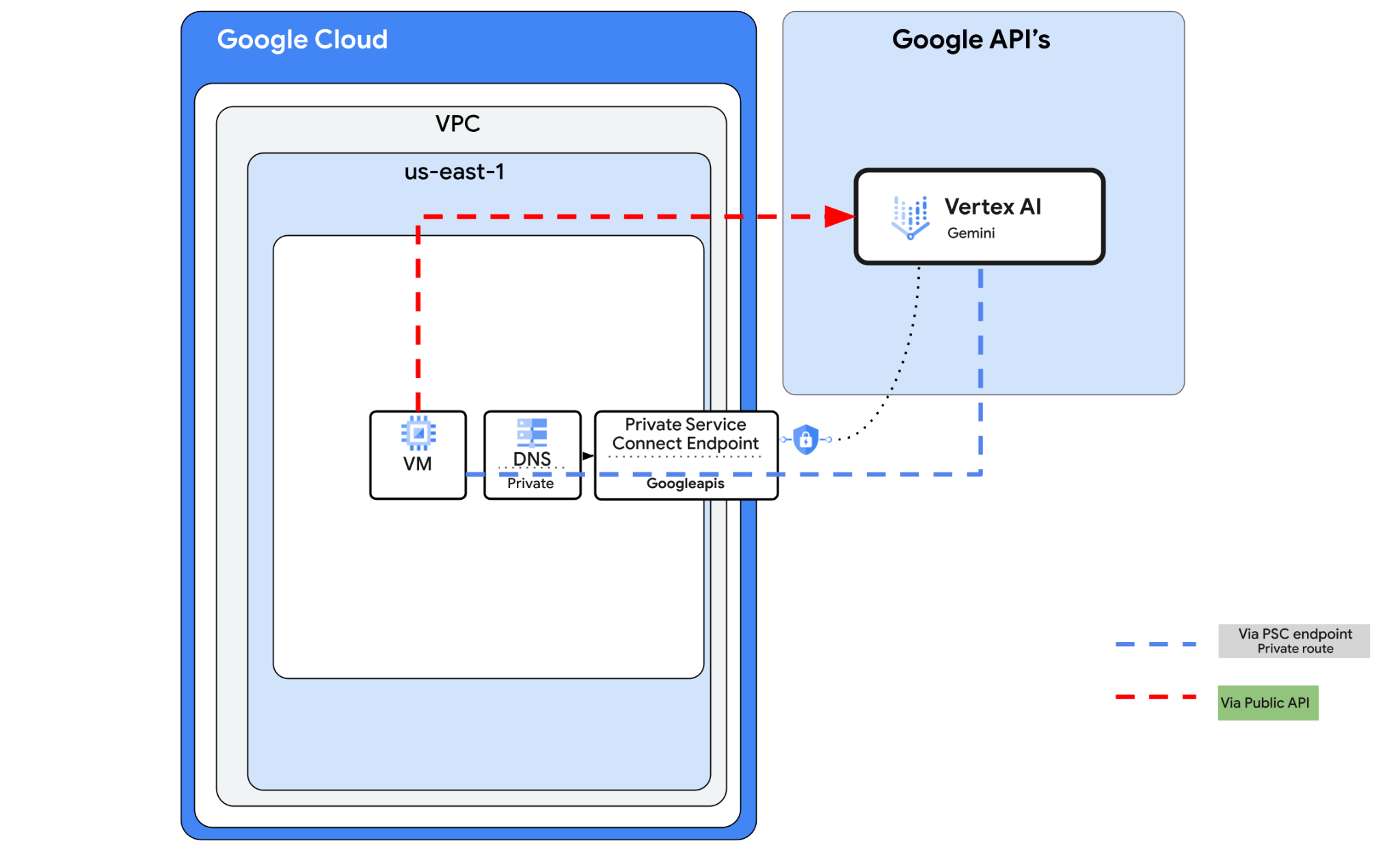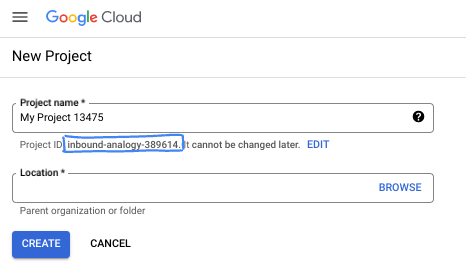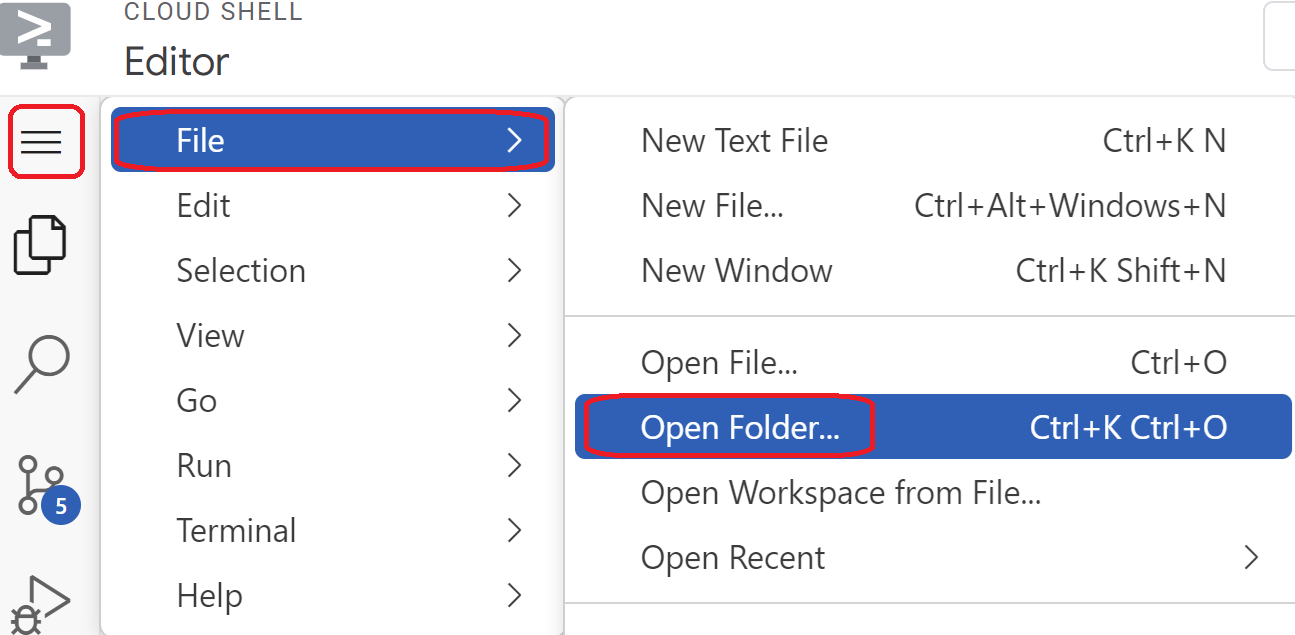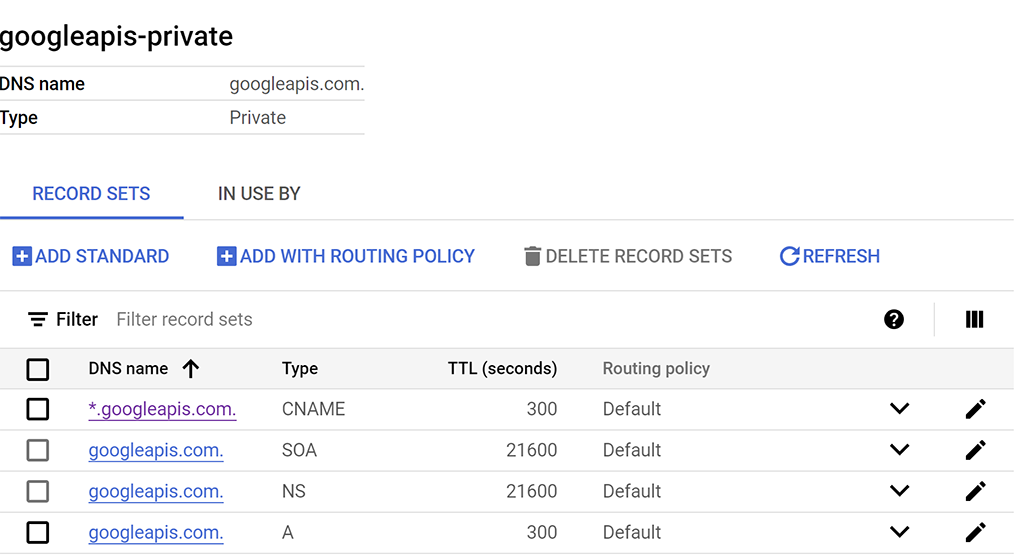1. Overview
Vertex AI API can be accessed over the internet, however, in your enterprise you may want to access the Vertex AI API's privately without going over the internet. In this lab you will first.
- Access the Gemini 3 Pro API via Vertex using python sdk
- This will be running on a VM instance
- Connection will be via Cloud NAT to the public internet.
Then you will create a Private Service Connect endpoint to Google APIs, and change the traffic flow to use the private endpoint to connect to the Gemini chat API. The configurations will be a combination of Terraform, gcloud and console.
In this lab, you're going to be creating the following pattern.
Figure1.

2. Objective
In this lab you will learn how to perform the following task:
- Set up VM instance to use python sdk
- Connect to Gemini chat via python script
- Configure PSC endpoint to connect to Googleapis
- Verify connectivity path to Googleais
- Configure manual DNS entries
Self-paced environment setup
- Sign-in to the Google Cloud Console and create a new project or reuse an existing one. If you don't already have a Gmail or Google Workspace account, you must create one.



- The Project name is the display name for this project's participants. It is a character string not used by Google APIs. You can always update it.
- The Project ID is unique across all Google Cloud projects and is immutable (cannot be changed after it has been set). The Cloud Console auto-generates a unique string; usually you don't care what it is. In most codelabs, you'll need to reference your Project ID (typically identified as
PROJECT_ID). If you don't like the generated ID, you might generate another random one. Alternatively, you can try your own, and see if it's available. It can't be changed after this step and remains for the duration of the project. - For your information, there is a third value, a Project Number, which some APIs use. Learn more about all three of these values in the documentation.
- Next, you'll need to enable billing in the Cloud Console to use Cloud resources/APIs. Running through this codelab won't cost much, if anything at all. To shut down resources to avoid incurring billing beyond this tutorial, you can delete the resources you created or delete the project. New Google Cloud users are eligible for the $300 USD Free Trial program.
Start Cloud Shell
While Google Cloud can be operated remotely from your laptop, in this codelab you will be using Google Cloud Shell, a command line environment running in the Cloud.
From the Google Cloud Console, click the Cloud Shell icon on the top right toolbar:

It should only take a few moments to provision and connect to the environment. When it is finished, you should see something like this:

This virtual machine is loaded with all the development tools you'll need. It offers a persistent 5GB home directory, and runs on Google Cloud, greatly enhancing network performance and authentication. All of your work in this codelab can be done within a browser. You do not need to install anything.
3. Task 1. Setup Environment with terraform
We will create a custom VPC with Firewall rules and subnet. Open the cloud console and select the project you will be using.
- Open Cloud Shell located at the top of your console on the right, ensure you see the correct project id in Cloud Shell, confirm any prompts to allow access.

- Create a folder called terraform-build and move to folder
mkdir terraform-build && cd terraform-build
- Create a main.tf and variable.tf file.
touch main.tf variable.tf
- Switch over to the Cloud Shell editor view. Select editor, ensure you allow any necessary prompts so the interface can load.
- Once loaded navigate to, File > Open Folder and go to the /home/your-user-name/terraform-build and select Ok to open the folder in the editor.

- Select the variable.tf file and add the following. Replace the
your-project-id-heretext with your actual project ID in quotes
variable "project_id" {
type = string
default = "your-project-id-here"
}
variable "network_id" {
type = string
default = "python-net"
}
- Next open the main.tf file. We are going to add some terraform code to perform various actions as explained below.
Enable API's |
|
Create VPC called python-net |
|
Add a subnet |
|
Add two Firewall rules |
|
- Copy and paste the following into the main .tf file.
resource "google_project_service" "default" {
project = var.project_id
for_each = toset([
"dns.googleapis.com",
"aiplatform.googleapis.com",
"servicedirectory.googleapis.com"
])
service = each.value
disable_on_destroy = false
}
resource "google_compute_network" "default" {
project = var.project_id
name = var.network_id
auto_create_subnetworks = false
mtu = 1460
routing_mode = "GLOBAL"
}
resource "google_compute_subnetwork" "default" {
name = "vm1-subnet"
ip_cidr_range = "10.0.11.0/24"
project = var.project_id
region = "us-east1"
stack_type = "IPV4_ONLY"
network = google_compute_network.default.id
}
resource "google_compute_firewall" "allow_icmp" {
name = "allow-icmp-${google_compute_network.default.name}"
network = google_compute_network.default.id
project = var.project_id
allow {
protocol = "icmp"
}
source_ranges = ["0.0.0.0/0"]
target_tags = ["allow-icmp"]
}
resource "google_compute_firewall" "allow_ssh" {
name = "allow-ssh-${google_compute_network.default.name}"
network = google_compute_network.default.id
project = var.project_id
allow {
protocol = "tcp"
ports = ["22"]
}
source_ranges = ["0.0.0.0/0"]
target_tags = ["allow-ssh"]
}
- Switch back to Cloud Shell terminal make sure your are in the terraform-build directory
cd terraform-buildand run the following commands
terraform init
Initializes the working directory. This step downloads the providers required for the given configuration.
terraform plan
Generates an execution plan, showing what actions Terraform will take to deploy your infrastructure.
- Now to create the resources run the
terraform applycommand and typeyesto run.
4. Task 2. Create NAT gateway and VMs with Terraform
We need to grant outbound external access to the internet so lets create a Cloud NAT gateway and attach it.
- Open Cloud Shell, navigate to terraform-build folder and create the following files (total three files). We will edit these later on.
touch nat-vm.tf psc.tf dns.tf
- Switch to Cloud Shell editor view and select the nat-vm.tf file and add the following Terraform code. This will create a NAT gateway and two VMs.
Terraform nat-vm.tf
resource "google_compute_router" "default" {
name = "py-outbound-nat"
region = "us-east1"
network = google_compute_network.default.id
project = var.project_id
bgp {
asn = 64514
}
}
resource "google_compute_router_nat" "default" {
name = "py-outbound-nat-gw"
router = google_compute_router.default.name
region = google_compute_router.default.region
nat_ip_allocate_option = "AUTO_ONLY"
project = var.project_id
source_subnetwork_ip_ranges_to_nat = "ALL_SUBNETWORKS_ALL_IP_RANGES"
log_config {
enable = true
filter = "ERRORS_ONLY"
}
}
resource "google_compute_instance" "vm1" {
name = "py-vm1"
zone = "us-east1-b"
machine_type = "n2-standard-2"
project = var.project_id
boot_disk {
initialize_params {
image = "debian-cloud/debian-12"
}
}
network_interface {
subnetwork = google_compute_subnetwork.default.id
stack_type = "IPV4_ONLY"
}
tags = ["allow-ssh", "allow-icmp"]
metadata_startup_script = <<-EOF
#! /bin/bash
sudo apt-get update
sudo apt-get install python3 python3-dev python3-venv git -y
sudo apt-get install tcpdump dnsutils -y
mkdir -p ~/py-gem-env
cd ~/py-gem-env
python3 -m venv env
source env/bin/activate
pip install --upgrade pip
pip install ipython google-genai
'
EOF
}
- Switch to Cloud Shell terminal, ensure your are in the terraform-build folder and run
terraform planthis will show you that 4 items will be added, then runterraform applyand typeyesto create the NAT gateway and vm.
5. Task 3. Configure VMs and test
- Navigate to VM instances. Select the vm starting with py-vm1. Choose SSH.
- Once you SSH into py-vm1, enable root by typing
sudo -i - Activate your venv environment:
cd py-gem-env
source env/bin/activate
- Now let's authenticate this to do some testing later on. Run the following command in the VM, press y when prompted.
gcloud auth application-default login
- Next copy the url which appears in the starting with https:// open a new tab in your lab browser window and paste the url. Accept the prompts.
- When you see the following select copy, switch back to the vm py-vm1 session and for Enter authorization code: paste the code you copied and press enter to authenticate.

- Now let's do a quick test to see if we can connect to the Vertex API, this uses the *-aiplatform.googleapis.com so we will do a
digto that address to see how the traffic routes.
dig *-aiplatform.googleapis.com
- You should see something similar (the address will differ). Note the path is via public IP addresses since the API is a public API. DON'T COPY
; <<>> DiG 9.18.41-1~deb12u1-Debian <<>> *-aiplatform.googleapis.com ;; global options: +cmd ;; Got answer: ;; ->>HEADER<<- opcode: QUERY, status: NOERROR, id: 60947 ;; flags: qr rd ra; QUERY: 1, ANSWER: 16, AUTHORITY: 0, ADDITIONAL: 1 ;; OPT PSEUDOSECTION: ; EDNS: version: 0, flags:; udp: 512 ;; QUESTION SECTION: ;*-aiplatform.googleapis.com. IN A ;; ANSWER SECTION: *-aiplatform.googleapis.com. 300 IN A 173.194.216.95 *-aiplatform.googleapis.com. 300 IN A 108.177.11.95 *-aiplatform.googleapis.com. 300 IN A 192.178.219.95 *-aiplatform.googleapis.com. 300 IN A 74.125.134.95 *-aiplatform.googleapis.com. 300 IN A 74.125.139.95 *-aiplatform.googleapis.com. 300 IN A 108.177.12.95 *-aiplatform.googleapis.com. 300 IN A 173.194.210.95 *-aiplatform.googleapis.com. 300 IN A 74.125.26.95 *-aiplatform.googleapis.com. 300 IN A 173.194.212.95 *-aiplatform.googleapis.com. 300 IN A 172.217.204.95
- Now let's use python. Type
ipythonto activate the ipython interface.
ipython

- Now copy and paste the following. This asks Gemini "What are all the colors of the Google logo" and "What is the color of the sky" .
from google import genai
from google.genai import types
import os
import sys
LOCATION = "global"
MODEL_ID = "gemini-3-pro-preview"
try:
client = genai.Client(vertexai=True, location=LOCATION)
print(f"Successfully initialized Google Gen AI Client (Vertex AI mode) in {LOCATION}")
except Exception as e:
print(f"Error initializing client: {e}")
print("Ensure you have installed the library: `pip install google-genai`")
print("And authenticated: `gcloud auth application-default login`")
sys.exit(1)
class SimpleChatSession:
def __init__(self, model_id):
self.model_id = model_id
self.history = []
def send_message(self, prompt, stream=True):
user_content = types.Content(
role="user",
parts=[types.Part(text=prompt)]
)
self.history.append(user_content)
try:
response_stream = client.models.generate_content_stream(
model=self.model_id,
contents=self.history,
config=types.GenerateContentConfig(
temperature=0.7
)
)
accumulated_text = ""
for chunk in response_stream:
if chunk.text:
yield chunk.text
accumulated_text += chunk.text
model_content = types.Content(
role="model",
parts=[types.Part(text=accumulated_text)]
)
self.history.append(model_content)
except Exception as e:
print(f"\n[Error during generation: {e}]")
def get_chat_response(session: SimpleChatSession, prompt: str):
print(f"\n--- User: {prompt} ---")
print("--- Model: ", end="")
stream_generator = session.send_message(prompt)
full_text = ""
for chunk_text in stream_generator:
full_text += chunk_text
print(chunk_text, end="", flush=True)
print()
return full_text
if __name__ == "__main__":
chat_session = SimpleChatSession(MODEL_ID)
get_chat_response(chat_session, "Hello.")
get_chat_response(chat_session, "What are all the colors of the Google logo?")
get_chat_response(chat_session, "What color is the sky?")
- Press enter twice to run and see the result.
- This request accessed Vertex via the public API.
- Close off SSH session let's continue.
6. Task 4. Create the PSC endpoint to googleapis with Terraform
To enable private connectivity to our Vertex API endpoint we will create a Private Service Connect endpoint for Google APIs. This will allow us to use a private IP address we assign to route traffic to the Google APIs we need, in this case Vertex.
- Open Cloud Shell in editor view if not open already. We are going to create the following:
- Create an IP for the PSC endpoint 192.168.255.250 (
resource "google_compute_global_address" "default") - Create a PSC endpoint to Google APIs (
resource "google_compute_global_forwarding_rule" "default")
Open the psc.tf file in the terraform-build folder. Add the following code to file.
Terraform psc.tf
resource "google_compute_global_address" "default" {
name = "vertex-ip"
purpose = "PRIVATE_SERVICE_CONNECT"
network = google_compute_network.default.id
address_type = "INTERNAL"
address = "192.168.255.250"
}
resource "google_compute_global_forwarding_rule" "default" {
name = "pscvertexgemini"
target = "all-apis"
network = google_compute_network.default.id
ip_address = google_compute_global_address.default.id
load_balancing_scheme = ""
}
- Switch to Cloud Shell terminal, ensure your are in the
terraform-buildfolder. Then runterraform initThen runterraform planthis will show you that 2 items will be added,
then runterraform applyand typeyesto create the IP and PSC Google APIs endpoint. - Verify endpoint exist
gcloud compute addresses list --filter="name=( 'vertex-ip' ...)"
gcloud compute forwarding-rules describe pscvertexgemini --global
7. Task 5. Create Manual DNS entry to googleapis with Terraform
You can create a manual DNS entry to point to the PSC endpoint using private DNS. This would affect all the networks you assign to it.
- Navigate to Network services and select Cloud DNS.
- In zones you should see an automatically created zone for the Private Service Connect for Google APIs, with zone type service directory. This can be used to connect to the PSC endpoint with the format **SERVICE-ENDPOINT.p.googleapis.com Example:
aiplatform-pscvertexgemini.p.googleapis.com - In this case we want to manually create a private DNS entry. The config will be as follows
- Create a private DNS zone named "googleapis-private" for "googleapis.com" and restrict it to the "python-net" network.
- Add an A record to map "googleapis.com" to the IP address "192.168.255.250".
- Add a CNAME record to redirect all subdomains of "googleapis.com" (e.g., www.googleapis.com) to "googleapis.com".
- Open Cloud Shell in editor view if not open already. Open the dns.tf file in the terraform-build folder. Add the following code to file.
Terraform dns.tf
resource "google_dns_managed_zone" "private_zone" {
name = "googleapis-private"
dns_name = "googleapis.com."
visibility = "private"
project = var.project_id
private_visibility_config {
networks {
network_url = google_compute_network.default.id
}
}
}
resource "google_dns_record_set" "a_record" {
name = "googleapis.com."
type = "A"
ttl = 300
managed_zone = google_dns_managed_zone.private_zone.name
project = var.project_id
rrdatas = ["192.168.255.250"]
}
resource "google_dns_record_set" "cname_record" {
name = "*.googleapis.com."
type = "CNAME"
ttl = 300
managed_zone = google_dns_managed_zone.private_zone.name
project = var.project_id
rrdatas = ["googleapis.com."]
}
- Switch to Cloud Shell terminal, ensure your are in the
terraform-buildfolder. Then runterraform planthis will show you what items will be added,
Then runterraform applyand typeyesto create the private DNS entry. - You should see a set up with an A record and CNAME like this see

- Next we verify connectivity with these changes on py-vm1
8. Task 6. Verify endpoint connectivity via IP address
Let's connect using the private endpoint to connect to Gemini.
- Go to VM Instance py-vm1. Select SSH and SSH into the VM
- Gain root access by typing
sudo -i - Check the connectivity path to aiplatform.googleapis.com using the
pingcommand. This will ping the IP address in the private DNS, A record for googleapis. This IP a PSC endpoint and your pings will be unsuccessful.
ping -c 2 aiplatform.googleapis.com
- Check the connectivity path with a
pingusing the automatically created DNS entry for PSC Google APIs withaiplatform-pscvertexgemini.p.googleapis.com. This points to the IP address of the PSC endpoint and your pings will be unsuccessful.
ping -c 2 aiplatform-pscvertexgemini.p.googleapis.com
- Check the connectivity path to aiplatform.googleapis.com using the
digcommand. This should be the IP address of the PSC endpoint.
dig aiplatform.googleapis.com
- Go back to the console and open another instance of VM Instance py-vm1. Select SSH and SSH into the VM
- Gain root access by typing
sudo -i - Run the follow command to see the connectivity in a TCP dump
sudo tcpdump -i any port 53 -n or host aiplatform.googleapis.com
- Now switch back to the first SSH instance of VM Instance py-vm1
- Activate the env using
cd py-gem-env
source env/bin/activate
- Now let's test python. Type
ipythonto activate the ipython interface.
ipython
- Now copy and paste the following. This asks Gemini "In one short sentence summarize what is a tokenizer in the context of AI?" and "Are whales awesome or not?".
from google import genai
from google.genai import types
import os
import sys
LOCATION = "global"
MODEL_ID = "gemini-3-pro-preview"
try:
client = genai.Client(vertexai=True, location=LOCATION)
print(f"Successfully initialized Google Gen AI Client (Vertex AI mode) in {LOCATION}")
except Exception as e:
print(f"Error initializing client: {e}")
print("Ensure you have installed the library: `pip install google-genai`")
print("And authenticated: `gcloud auth application-default login`")
sys.exit(1)
class SimpleChatSession:
def __init__(self, model_id):
self.model_id = model_id
self.history = []
def send_message(self, prompt, stream=True):
user_content = types.Content(
role="user",
parts=[types.Part(text=prompt)]
)
self.history.append(user_content)
try:
response_stream = client.models.generate_content_stream(
model=self.model_id,
contents=self.history,
config=types.GenerateContentConfig(
temperature=0.7
)
)
accumulated_text = ""
for chunk in response_stream:
if chunk.text:
yield chunk.text
accumulated_text += chunk.text
model_content = types.Content(
role="model",
parts=[types.Part(text=accumulated_text)]
)
self.history.append(model_content)
except Exception as e:
print(f"\n[Error during generation: {e}]")
def get_chat_response(session: SimpleChatSession, prompt: str):
print(f"\n--- User: {prompt} ---")
print("--- Model: ", end="")
stream_generator = session.send_message(prompt)
full_text = ""
for chunk_text in stream_generator:
full_text += chunk_text
print(chunk_text, end="", flush=True)
print()
return full_text
if __name__ == "__main__":
chat_session = SimpleChatSession(MODEL_ID)
get_chat_response(chat_session, "Hello.")
get_chat_response(chat_session, "In one short sentence summarize what is a tokenizer in the context of AI?")
get_chat_response(chat_session, "Are whales awesome or not?")
- Press enter twice to run and see the result.
- Switch back over to the second instance of VM Instance py-vm1. You should see the result of the TCPDUMP. You will notice in and out and the IP address of the VM is using the PSC endpoint IP address to connect to aiplatform.googleapis.com
Close all SSH sessions to VM Instance py-vm1
9. Clean Up
- Go to Cloud Shell make sure you are in the terraform-build directory
cd terraform-build - Run the
terraform plan destroyto see all the changes that will be made
terraform plan -destroy
- Then run the command
terraform destroyand then typeyesand all the resources you created in your project with Terraform will be removed.
terraform destroy
10. Congratulations
Congratulations, you've successfully connected to Vertex and used Gemini 3 pro via public API address and privately using Private Service Connect Endpoint for Google APIs. This functionality can extend private API connectivity into your on-prem/other cloud environment which are connected via (Interconnect, Cross-Cloud Interconnect and VPC).
Next steps / Learn more
You can read more about Vertex AI networking
Codelab: Access Anthropic Claude on Vertex AI with python sdk via Private Service Connect endpoint
Take your next lab
Continue your quest with Google Cloud, and check out these other Google Cloud Skills Boost labs:
